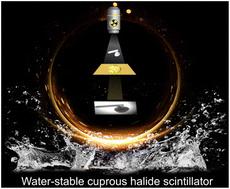Zero-dimensional cuprous halide scintillator with ultra-high anti-water stability for X-ray imaging
IF 5.3
2区 材料科学
Q2 MATERIALS SCIENCE, MULTIDISCIPLINARY
引用次数: 0
Abstract
Zero-dimensional (0D) cuprous organic–inorganic hybrid halides have emerged as a new kind of scintillator due to their high light yield and adjustable emission properties in the whole visible spectral range. However, their practical application in the radiation industry is seriously hindered by the instability of CuI ions under humid atmospheres and oxidizing environments. Herein, we designed a new Cu(I)-based halide of [CEOMTPP]2Cu4Br6 (CEOMTPP = ethoxycarbonylmethyl(triphenyl) phosphonium cation) containing a discrete [Cu4Br6]2− nanocluster, which displays strong broadband yellow light emission with near-unity photoluminescence quantum yield (PLQY) and large Stokes shift of 206 nm. Remarkably, [CEOMTPP]2Cu4Br6 shows ultra-high anti-water and anti-oxidation stability with steady emitting performance in water for over one year and in an acid–base aqueous solution for one day. Benefiting from the near-unity PLQY, large Stokes shift and negligible self-absorption, [CEOMTPP]2Cu4Br6 exhibits excellent scintillation properties with a high light yield of 69 500 phonon per meV and low detection limit of 113.0 nGy s−1. Furthermore, a high spatial resolution of 14.5 lp mm−1 is achieved in X-ray imaging based on a [CEOMTPP]2Cu4Br6@EVA composite-assembled scintillation screen, demonstrating its potential application in medical photography. This research provides a fundamental structural engineering strategy to design highly efficient and stable low-dimensional Cu(I) halides for X-ray radiation application.

用于 X 射线成像的具有超高抗水稳定性的零维卤化亚铜闪烁体
零维(0D)亚铜有机-无机杂化卤化物因其在整个可见光谱范围内的高产光率和可调发射特性而成为一种新型闪烁体。然而,由于 CuI 离子在潮湿大气和氧化环境下的不稳定性,严重阻碍了它们在辐射行业的实际应用。在此,我们设计了一种新的铜(I)基卤化物[CEOMTPP]2Cu4Br6(CEOMTPP = 乙氧基羰基甲基(三苯基)鏻阳离子),其中含有一个离散的[Cu4Br6]2-纳米团簇,它能以接近均一的光致发光量子产率(PLQY)和 206 nm 的大斯托克斯偏移显示出强烈的宽带黄光发射。值得注意的是,[CEOMTPP]2Cu4Br6 具有超高的抗水和抗氧化稳定性,在水中可稳定发光一年以上,在酸碱水溶液中可稳定发光一天。由于[CEOMTPP]2Cu4Br6 具有近乎统一的 PLQY、较大的斯托克斯偏移和可忽略的自吸收,因此具有优异的闪烁特性,光产率高达 69 500 phonon per meV,探测限低至 113.0 nGy s-1。此外,基于[CEOMTPP]2Cu4Br6@EVA 复合组装的闪烁屏在 X 射线成像中实现了 14.5 lp mm-1 的高空间分辨率,证明了其在医学摄影中的潜在应用。这项研究为设计用于 X 射线辐射的高效、稳定的低维 Cu(I)卤化物提供了基本的结构工程策略。
本文章由计算机程序翻译,如有差异,请以英文原文为准。
求助全文
约1分钟内获得全文
求助全文
来源期刊

ACS Applied Nano Materials
Multiple-
CiteScore
8.30
自引率
3.40%
发文量
1601
期刊介绍:
ACS Applied Nano Materials is an interdisciplinary journal publishing original research covering all aspects of engineering, chemistry, physics and biology relevant to applications of nanomaterials. The journal is devoted to reports of new and original experimental and theoretical research of an applied nature that integrate knowledge in the areas of materials, engineering, physics, bioscience, and chemistry into important applications of nanomaterials.
 求助内容:
求助内容: 应助结果提醒方式:
应助结果提醒方式:


